The OES Fezzes are more than bright headpieces. They have deeper significance for Order of the Eastern Star members. Every fez expresses pride, unity, and tradition. Through the years, these fezzes have become an outward sign of distinction.
They bond members to their heritage and emphasize their part in Masonic existence. Here, you will discover where they originated, what they symbolize, and why they are still relevant today. The history of OES Fezzes is one of intriguing symbolism, artistry, and culture.
Introduction to OES Fezzes
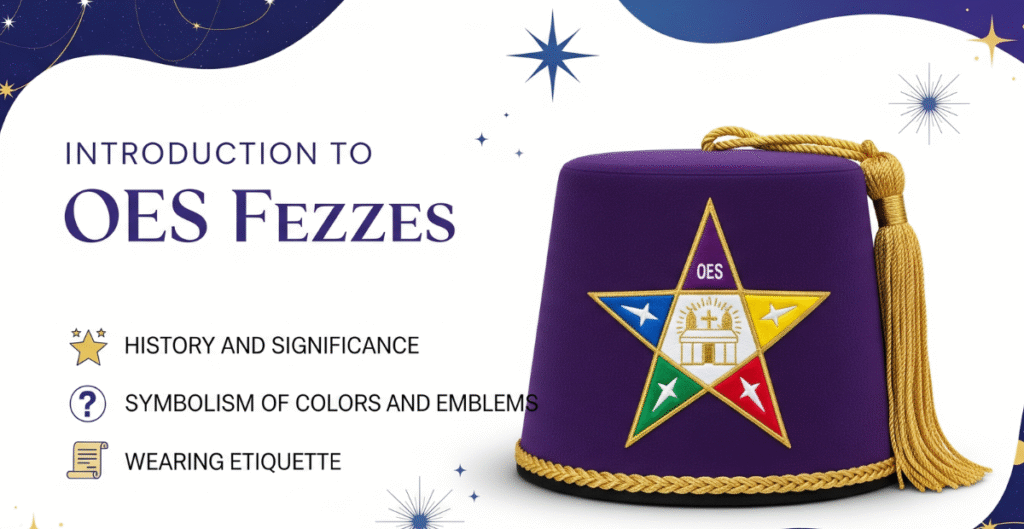
The Order of the Eastern Star, known as OES, is one of the largest fraternal groups for both men and women linked to Freemasonry. Founded in the mid-1800s, it gave members a way to celebrate faith, charity, and unity. Within this group, OES Fezzes became a central piece of attire. They stand out in ceremonies, parades, and official gatherings.
The fez itself has an older history, tracing back to the Ottoman Empire. Freemasons later adopted it as a ceremonial headdress. For OES, the fez turned into a sign of pride. When a member wears one, it shows dedication, belonging, and respect for the order’s values.
Symbolism of the OES Fez
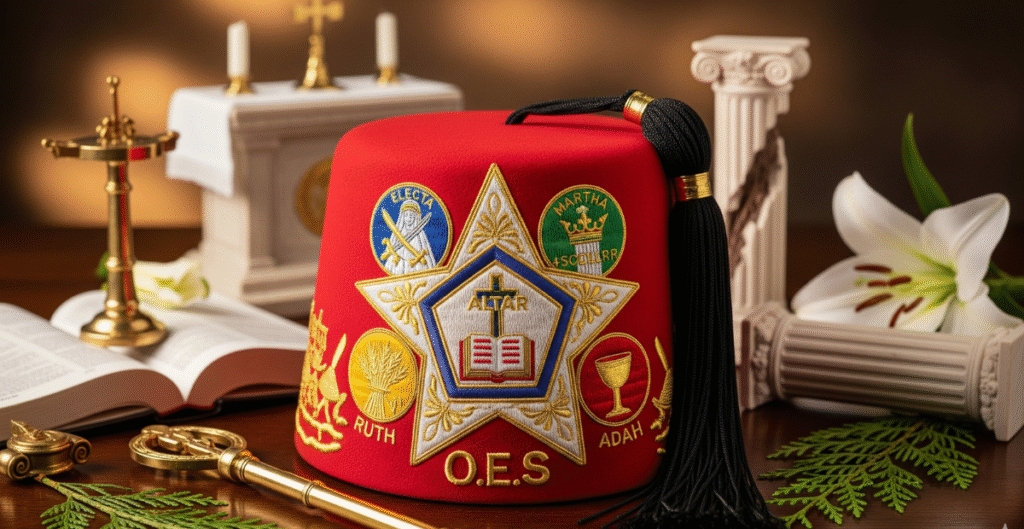
Every part of the OES Fezzes carries meaning. The five-pointed star is the most common symbol, each point linked to biblical heroines and moral lessons. This star reminds members of purity, strength, loyalty, faith, and love.
The colors also matter. Gold stitching reflects light and honor. The rich red background often seen in OES designs speaks of courage and sacrifice. Jewels or metallic thread make the fez stand out, turning it into a badge of dignity. Together, these designs make the fez more than an accessory. It becomes a symbol of shared values.
See more: The Complete Guide to DOL Fezzes
Design and Styles of OES Fezzes
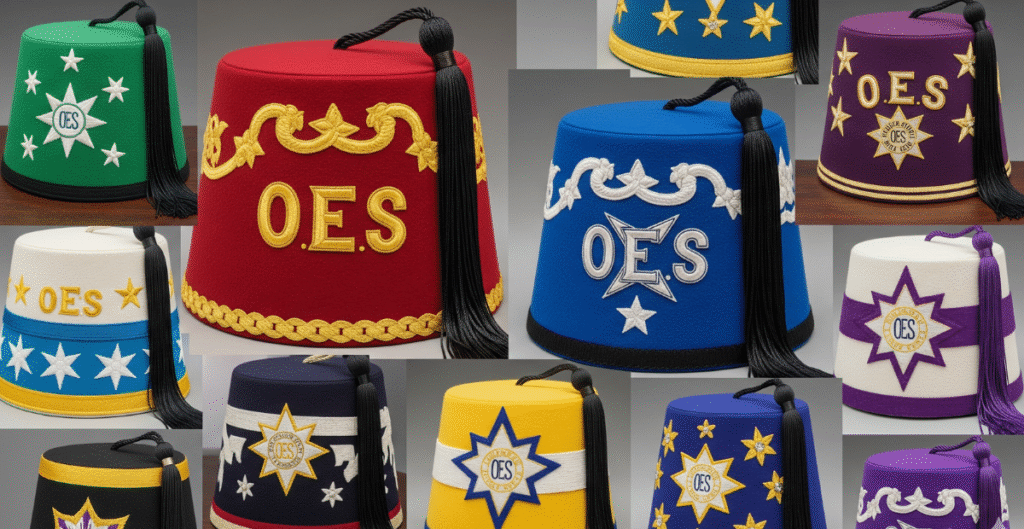
Traditional OES Fezzes are usually deep red with the OES star on the front. Yet, not all fezzes look the same. Some are made with velvet, others with felt, and many feature different tassel lengths or colors.
Chapters often customize their fezzes. Officers may have extra embroidery or jewels that mark their rank. Some fezzes are created for conventions or special anniversaries. These changes keep the tradition alive while letting each group show personality.
Occasions and Protocol for Wearing OES Fezzes
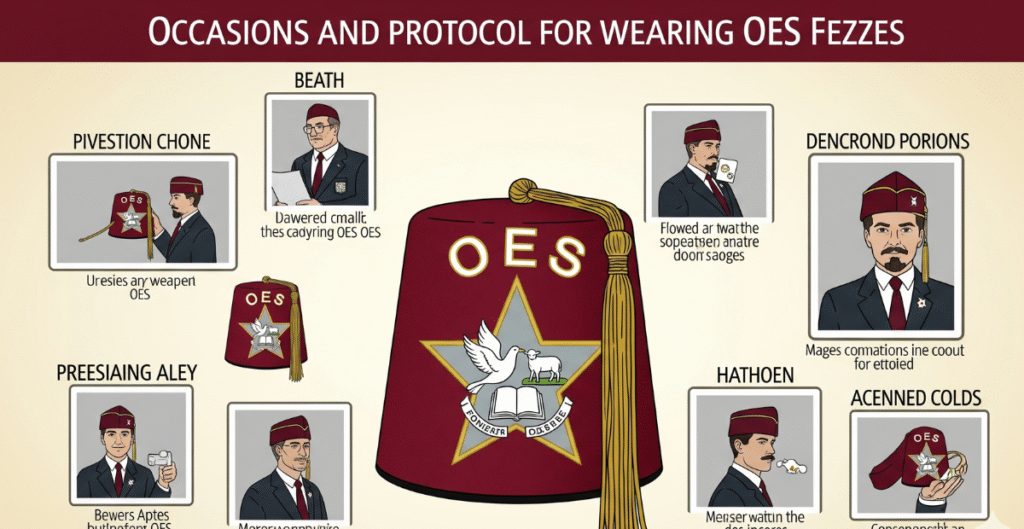
The fez is not worn at random. Members use it on important occasions such as chapter meetings, ceremonies, and parades. It helps create a unified appearance and signals respect for the traditions of OES.
There is etiquette too. Members are expected to wear the fez properly, keeping it clean and upright. It should only be worn during approved gatherings, never as casual wear. This rule keeps the dignity of the fez intact and shows its role as a sacred emblem.
Differences Between OES Fezzes and Other Masonic Fezzes
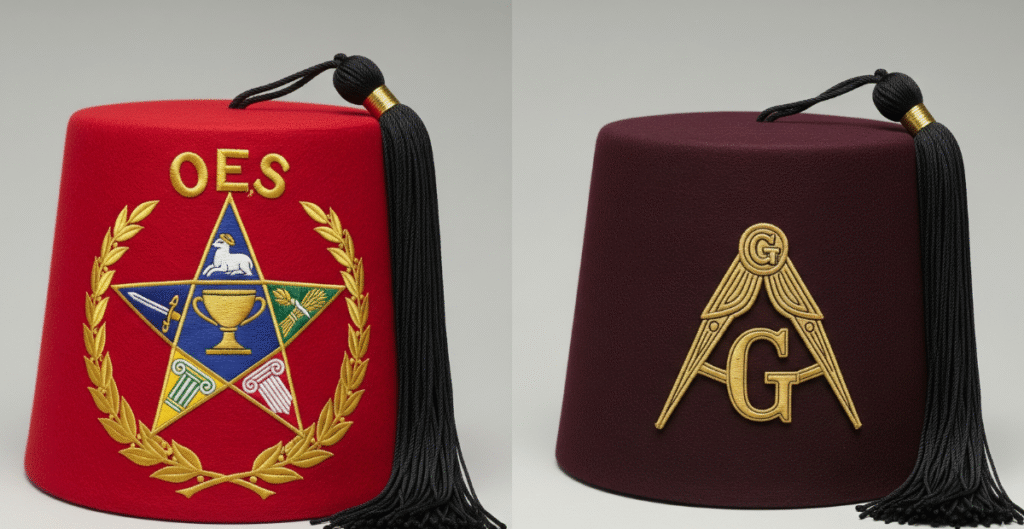
Many Masonic bodies use fezzes, but each group has unique symbols. Shriners are known for their bright red fezzes with large tassels and crescent emblems. Blue Lodge Masons and other affiliated groups may use different markings.
OES Fezzes stand apart with their five-pointed star. This star is the heart of Eastern Star identity. While all Masonic fezzes symbolize unity and heritage, the designs make it clear which branch of Masonry a member belongs to.
Craftsmanship and Materials Used in OES Fezzes
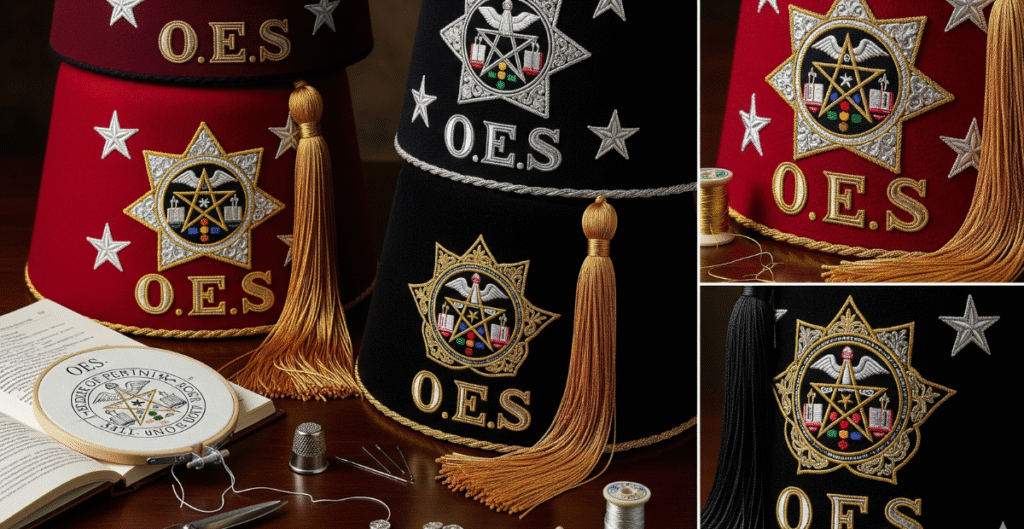
A fez may look simple, but quality makes a big difference. Traditional OES Fezzes are made from felt, wool blends, or velvet. These fabrics are chosen for their durability and rich texture.
The embroidery is often done by hand. Skilled crafters add metallic threads, jewels, and colored stitching. Machine-made versions are also common today, offering lower prices while still displaying the same symbols. The choice between hand and machine work usually depends on budget and occasion.
Collecting and Preserving OES Fezzes
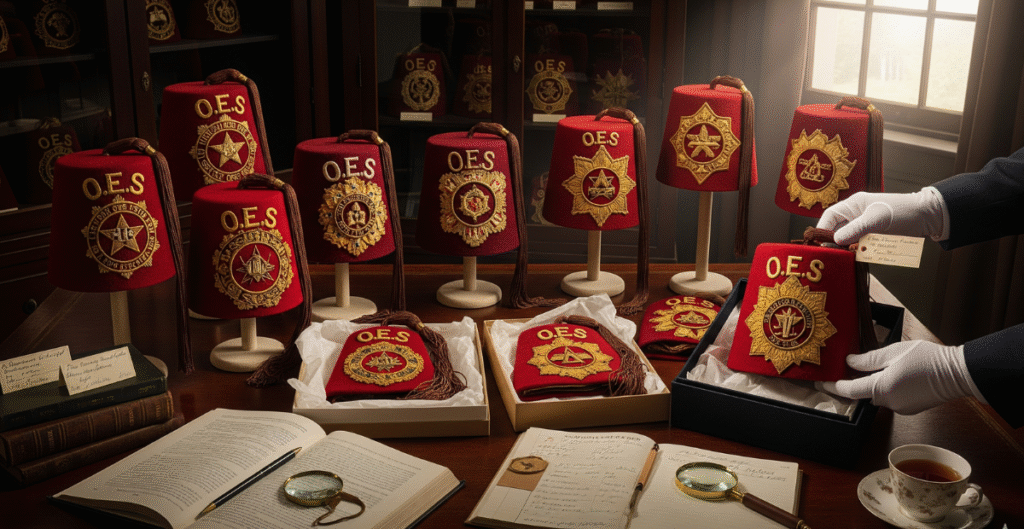
For collectors, OES Fezzes hold both sentimental and historical value. Vintage fezzes from early OES chapters are prized items. They tell stories of past ceremonies and the people who wore them.
Proper care matters. Fezzes should be stored away from sunlight to avoid fading. They need to be kept dry, as moisture can ruin fabric and embroidery. Gentle cleaning and using padded storage boxes can help preserve them for future generations. Many collectors also track market values, which can range widely based on age, condition, and rarity.
Care Tips for OES Fezzes
| Care Step | Why It Matters | Best Practice |
| Storage | Prevent fading and dust | Use dark, dry, padded boxes |
| Cleaning | Protect fabric and embroidery | Spot clean only, avoid water |
| Handling | Keep shape intact | Hold from the base, not tassel |
| Display | Reduce wear and tear | Rotate displays, use cases |
Modern Use and Evolving Trends

Today’s OES members continue to wear the fez, but its use has shifted. Younger members often see it as a way to connect with heritage. Some chapters now order custom-made fezzes with updated designs that feel both modern and traditional.
The rise of online marketplaces has also shaped trends. Members can now order fezzes online, trade vintage ones, or join collector groups. This has kept the fez visible even outside traditional OES circles.
Cultural and Fraternal Importance Today

For many, OES Fezzes remain a link to identity. They remind members of shared values and the bond of fraternity. In public events like parades, the fez helps the group stand out and share its message with the community.
The fez also connects OES members to the larger Masonic family. While every branch has its own designs, the fez acts as a common thread, showing the pride and unity across Masonic orders. Its cultural weight makes it both a personal and public symbol.
Differences Between OES and Shriner Fezzes
| Feature | OES Fez | Shriner Fez |
| Symbol | Five-pointed star | Crescent with scimitar |
| Common Fabric | Felt, velvet, wool | Felt or velvet |
| Use | Ceremonies, parades, OES events | Parades, charity, Shriner events |
| Tassel | Standard black or gold | Often long and black |
| Identity | Order of the Eastern Star | Shrine of North America |
Historical Evolution of OES Fezzes
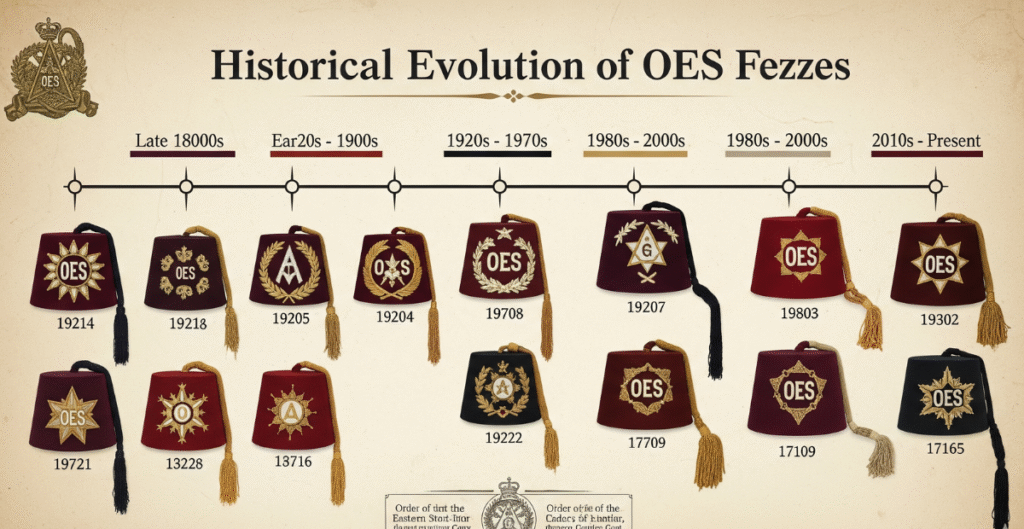
The story of OES Fezzes has changed through the years. Early versions were simpler, often just plain felt caps with the star emblem stitched by hand. They carried little decoration but meant a lot to the members who wore them. Over time, chapters began adding richer fabrics, jewels, and detailed embroidery to show pride and status.
By the mid-20th century, fezzes became more ornate, especially for officers. Gold thread, colored stones, and custom tassels were added. These upgrades gave each fez a sense of identity. They also helped preserve the fez as a key ceremonial object when other parts of regalia began fading in daily use.
YOU WILL LIKE : Shriner Fez Hat: History, Symbolism, and Modern Relevance
Regional Variations in OES Fezzes
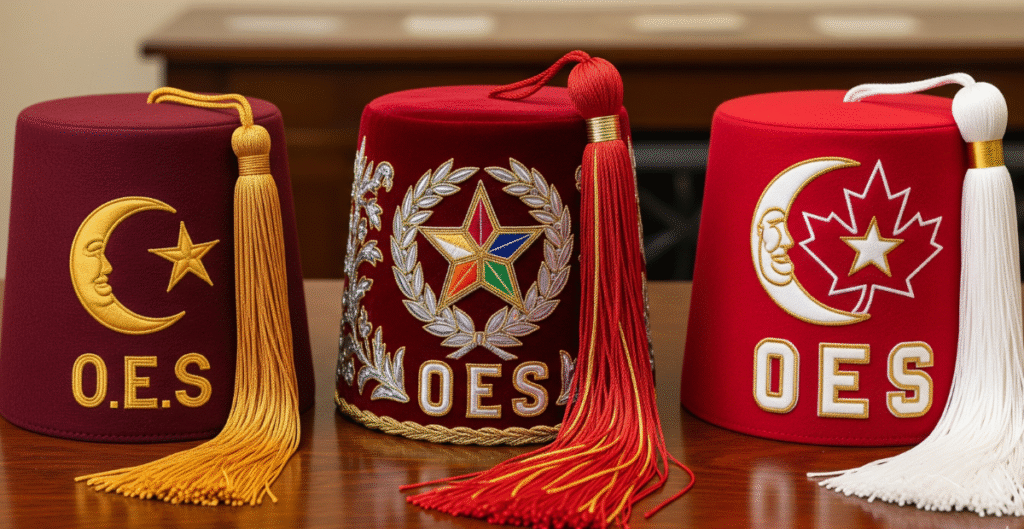
Not every fez looks the same across the world. In the United States, OES Fezzes are usually red velvet with the five-pointed star in colored enamel. In some regions, chapters prefer darker shades of maroon or even white fezzes for special roles. These small changes reflect local taste and tradition.
International chapters also add their own twists. For example, fezzes made in the Caribbean sometimes use brighter embroidery, while chapters in Europe favor more formal and minimalist styles. These regional variations prove that the fez is not a fixed design but a living symbol that adapts while keeping the OES identity.
Role of OES Fezzes in Public Perception
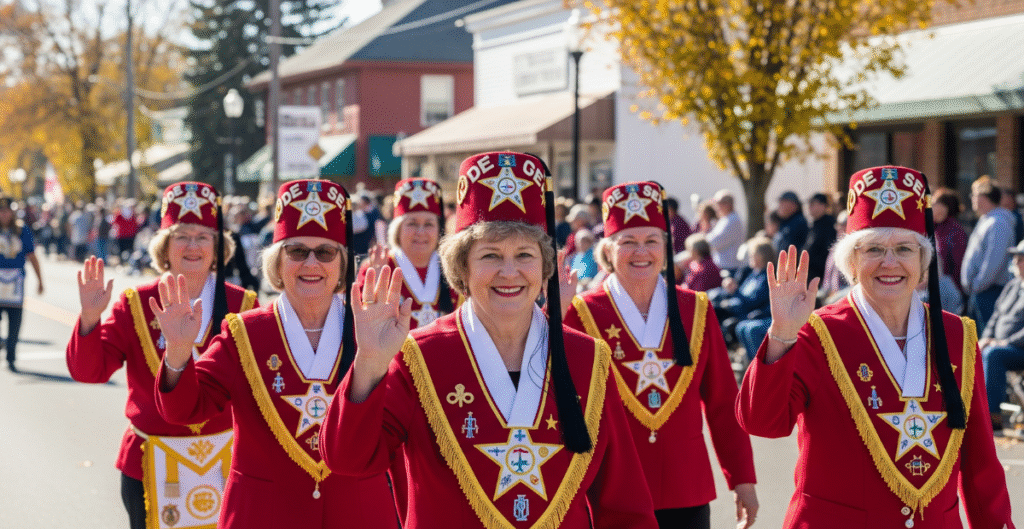
The fez is not only important to members but also to the public. When people see OES Fezzes in parades or events, they recognize the order’s presence. The fez acts as a uniform that sets OES apart and sparks curiosity about its purpose and history.
This visibility matters. Public recognition has helped OES build respect and show its charitable side. Many communities see the fez as a mark of service, linking it to the order’s acts of kindness and giving. The fez, therefore, serves both as a private emblem and a public ambassador.
Common Materials Used in OES Fezzes
| Material | Benefits | Drawbacks |
| Felt | Affordable, durable | Less luxurious appearance |
| Velvet | Rich look, ceremonial quality | Can attract dust easily |
| Wool blend | Strong, long-lasting | May be heavier to wear |
| Satin | Smooth finish, shines in light | Less durable over time |
Faq”s
What does the OES star on the fez mean?
The five-pointed star stands for biblical heroines and core values like faith and loyalty.
Are OES Fezzes different from Shriner fezzes?
Yes, Shriner fezzes feature a crescent emblem, while OES fezzes display the star symbol.
Can anyone buy an OES Fez?
Fezzes are typically reserved for members, though vintage ones may appear in collector markets.
How do you clean an OES Fez?
They should only be gently spot cleaned. Avoid soaking or washing to preserve fabric and embroidery.
Are OES Fezzes still used today?
Yes, they are worn at ceremonies, parades, and conventions. Many chapters also order custom designs.
Conclusion
The OES Fezzes are more than ceremonial hats. They are symbols of pride, unity, and the values of the Order of the Eastern Star. From their star emblem to their craftsmanship, they link members to tradition while adapting to modern times.
Cared for and respected, these fezzes remind each generation of its duty and connection to the past. The story of OES Fezzes is one of heritage, meaning, and dignity that continues to shine today.




